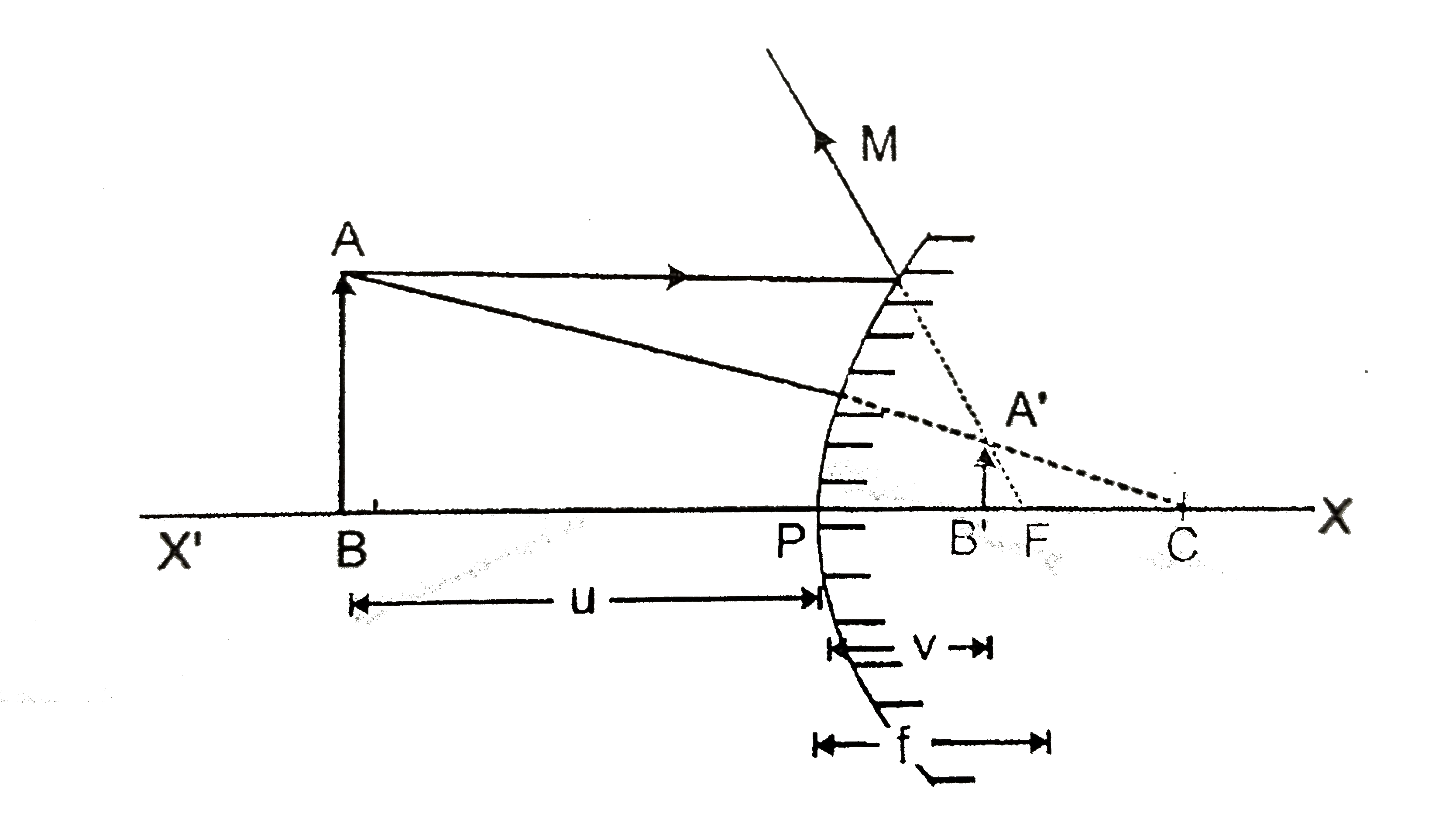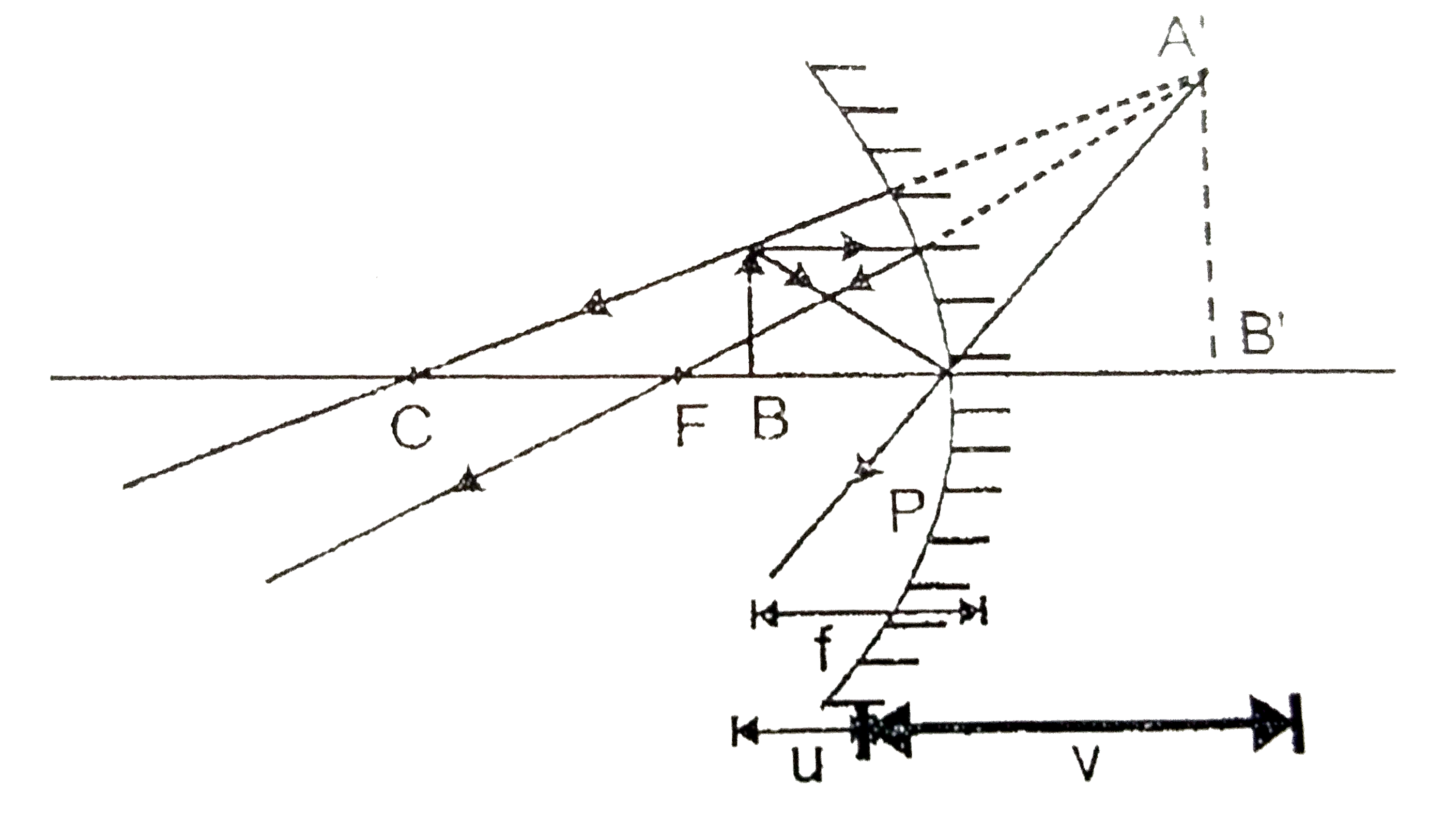Use the mirror equation to deduct that :
(a) an object between f and 2f of a concave mirror produces a real image beyond 2f.
(b) a convex mirror always produces a virtual image independent of the location of the object.
( c) the virtual image produced by a convex mirror is always diminished in size and is located between the focus and the pole.
(d) an object placed between the pole and focus of a concave mirror produces a virtual and enlarged image.
(a) As ΔsABC and A'B'C are similar
∴ABA'B'=CBCB'……..(I)
Again as ΔsABP and A'B'P are similar
ABA'B'=PBCB'……..(ii)
From (i) and (ii)
ABA'B=PBPB'…….(iii)
Measuring all distance from P , we have
CB=PB−PC
CB'=PC−PB'
∴ from (iii)
PB−PCPC−PB'=PBPB'........(iv)
Using New Cartisian sign conventions,
PB=−u
PC=−R
PB'=−v
We get from (iv)
−u+R−R+v=−u−v
or +uR−uv=uv−vR
uR+vR=2uv
Dividing both sides by uvR, we get
1v+1u=2R
As 1v+1u=2R=22f=1f
⇒1v+1u=1f

(b) According to sign conventions,
PB'=−u,PB'=+v
PB=f,PC=2f
ΔsABC and A'B'C are similar
∴ABA'B'=CBB'C
But all distances along the principal axis should be measured from the pole of the mirror.
ABA'B'=PC+PBPC−PB'
Since the aperture of the mirror is small therefore MP can be regarded as a straight line.
ΔsMPF and A'B'F are similar
MPA'B'=PFB'F=PFPF−PB' or ABA'B'=ff−v........(ii)
from (i) and (ii)
2f−u2f−v=ff−v
2f2−2fv−uf+uv=2f2−vf
−fv−uf+uv=0
uv=fv+fu
Dividing by uvf, we get
1f=1u+1v

(c) PB−PCPC−PB'=PBPB'........(i)
Proceeding as above, we get
CBCB'=PBPB'...........(ii)
Measuring all distance from O, we get
CB=PC−PB
CB'=PC+PB
From (i)
PC−PBPC+PB'=PBPB'
Using New cartisian sign conventins,
PB=-u,PB=+v<br>PC=-R=(-R+u)/(-R+V)=(-u)/(v)<br>oruR-uv=vR+uv<br>uR+vR=2 uv<br>Divg⊥hssbyuvR,we≥t<br>(1)/(v)+(1)/(u)=(2)/(R)=(2)/(2f)=(1)/(f) , (1)/(v)+(1)/(u)=(1)/(f)

Topper's Solved these Questions
- GEOMATRICAL OPTICS BOOK - RESONANCE ENGLISHCHAPTER - GEOMATRICAL OPTICS EXERCISE - Advance level Problems
35 Videos
- GEOMATRICAL OPTICS BOOK - RESONANCE ENGLISHCHAPTER - GEOMATRICAL OPTICS EXERCISE - Exercise-2
62 Videos
- EXPERIMENTAL PHYSICSBOOK - RESONANCE ENGLISHCHAPTER - EXPERIMENTAL PHYSICSEXERCISE - PART -II
10 Videos
- GRAVITATIONBOOK - RESONANCE ENGLISHCHAPTER - GRAVITATIONEXERCISE - HIGH LEVEL PROBLEMS
16 Videos
Similar Questions
A convex mirror always produces a virtual image of real object independent of the location of the object use mirror equation to peove it.
View SolutionImage of an object in a convex mirror is
View SolutionThe image formed in a convex mirror is always erect and enlarged.
View SolutionA : Plane and convex mirrors can produce real images of objects.
R : A plane of convex mirror can produce a real image if the object is virtual.
View SolutionNature of image of a real object formed by convex mirror is always
View SolutionThe image by a convex mirror is always formed in front of the mirror.
View SolutionA convex mirror always forms virtual and diminished images. _____
View SolutionA concave mirror of focal length f produces a real image n times the size of the object. What is the distance of the object from the mirror?
View SolutionThe minimum distance between the object and its real image for concave mirror is
View SolutionFind the nature of image when an object is placed at 2f from the pole of a convex mirror of focal length f
View Solution
